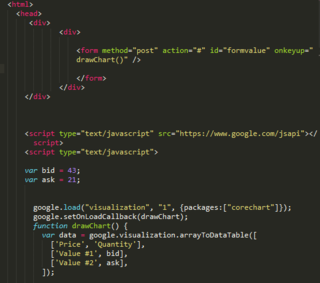Related Research Articles

JavaScript, often abbreviated JS, is a programming language that is one of the core technologies of the World Wide Web, alongside HTML and CSS. Over 97% of websites use JavaScript on the client side for web page behavior, often incorporating third-party libraries. All major web browsers have a dedicated JavaScript engine to execute the code on users' devices.

Internet Explorer is a discontinued series of graphical web browsers developed by Microsoft and included in the Microsoft Windows line of operating systems, starting in 1995. It was first released as part of the add-on package Plus! for Windows 95 that year. Later versions were available as free downloads, or in-service packs, and included in the original equipment manufacturer (OEM) service releases of Windows 95 and later versions of Windows. New feature development for the browser was discontinued in 2016 in favor of new browser Microsoft Edge. Since Internet Explorer is a Windows component and is included in long-term lifecycle versions of Windows such as Windows Server 2019, it will continue to receive security updates until at least 2029. Microsoft 365 ended support for Internet Explorer on August 17, 2021, and Microsoft Teams ended support for IE on November 30, 2020. Internet Explorer is set for discontinuation on June 15, 2022, after which the alternative will be Microsoft Edge with IE mode for legacy sites.

Cross-site scripting (XSS) is a type of security vulnerability that can be found in some web applications. XSS attacks enable attackers to inject client-side scripts into web pages viewed by other users. A cross-site scripting vulnerability may be used by attackers to bypass access controls such as the same-origin policy. Cross-site scripting carried out on websites accounted for roughly 84% of all security vulnerabilities documented by Symantec up until 2007. XSS effects vary in range from petty nuisance to significant security risk, depending on the sensitivity of the data handled by the vulnerable site and the nature of any security mitigation implemented by the site's owner network.

Privilege escalation is the act of exploiting a bug, a design flaw, or a configuration oversight in an operating system or software application to gain elevated access to resources that are normally protected from an application or user. The result is that an application with more privileges than intended by the application developer or system administrator can perform unauthorized actions.
In computing, Download.ject is a malware program for Microsoft Windows servers. When installed on an insecure website running on Microsoft Internet Information Services (IIS), it appends malicious JavaScript to all pages served by the site.

Windows Internet Explorer 7 (IE7) is a web browser for Windows. It was released by Microsoft on October 18, 2006. Internet Explorer 7 is part of a long line of versions of Internet Explorer and was the first major update to the browser since 2001. It is the default browser in Windows Vista, Windows Server 2008 and Windows Embedded POSReady 2009 and can replace Internet Explorer 6 on Windows XP and Windows Server 2003 but unlike version 6, this version does not support Windows NT 4.0, Windows 98, Windows 98 SE, Windows 2000, and Windows Me. It also does not support Windows 7, Windows Server 2008 R2 or later Windows Versions.

In computer security, arbitrary code execution (ACE) is an attacker's ability to run any commands or code of the attacker's choice on a target machine or in a target process. An arbitrary code execution vulnerability is a security flaw in software or hardware allowing arbitrary code execution. A program that is designed to exploit such a vulnerability is called an arbitrary code execution exploit. The ability to trigger arbitrary code execution over a network is often referred to as remote code execution (RCE).
Microsoft Internet Explorer 6 (IE6) is a graphical web browser developed by Microsoft for Windows operating systems. Released on August 24, 2001, it is the sixth, and by now discontinued, version of Internet Explorer and the successor to Internet Explorer 5. It was the default browser in Windows XP and Windows Server 2003 and can replace previous versions of Internet Explorer on Windows NT 4.0 SP6a, Windows 98, Windows 2000 and Windows ME but unlike version 5, this version does not support Windows 3.1x, Windows NT 3.x and Windows 95. Internet Explorer 6 is the last version of Internet Explorer to support Windows NT 4.0 SP6a, Windows 98, Windows 2000, Windows ME, Windows XP versions below SP2 and Windows Server 2003 below SP1; as the following version, Internet Explorer 7, will only support Windows XP SP2 or later and Windows Server 2003 SP1 or later. IE6 SP2+ and IE7 were only included in or available (IE7) for Windows XP SP2+.
A ping of death is a type of attack on a computer system that involves sending a malformed or otherwise malicious ping to a computer.
The Windows Metafile vulnerability—also called the Metafile Image Code Execution and abbreviated MICE—is a security vulnerability in the way some versions of the Microsoft Windows operating system handled images in the Windows Metafile format. It permits arbitrary code to be executed on affected computers without the permission of their users. It was discovered on December 27, 2005, and the first reports of affected computers were announced within 24 hours. Microsoft released a high-priority update to eliminate this vulnerability via Windows Update on January 5, 2006. Attacks using this vulnerability are known as WMF exploits.
In computer security, heap spraying is a technique used in exploits to facilitate arbitrary code execution. The part of the source code of an exploit that implements this technique is called a heap spray. In general, code that sprays the heap attempts to put a certain sequence of bytes at a predetermined location in the memory of a target process by having it allocate (large) blocks on the process's heap and fill the bytes in these blocks with the right values.
JSONP, or JSON-P, is a historical JavaScript technique for requesting data by loading a <script> element, which is an element intended to load ordinary JavaScript. It was proposed by Bob Ippolito in 2005. JSONP enables sharing of data bypassing same-origin policy, which disallows running JavaScript code to read media DOM elements or XMLHttpRequest data fetched from outside the page's originating site. The originating site is indicated by a combination of URI scheme, host name, and port number.

Clickjacking is a malicious technique of tricking a user into clicking on something different from what the user perceives, thus potentially revealing confidential information or allowing others to take control of their computer while clicking on seemingly innocuous objects, including web pages.
Cross-site request forgery, also known as one-click attack or session riding and abbreviated as CSRF or XSRF, is a type of malicious exploit of a website where unauthorized commands are submitted from a user that the web application trusts. There are many ways in which a malicious website can transmit such commands; specially-crafted image tags, hidden forms, and JavaScript XMLHttpRequests, for example, can all work without the user's interaction or even knowledge. Unlike cross-site scripting (XSS), which exploits the trust a user has for a particular site, CSRF exploits the trust that a site has in a user's browser.
Browser security is the application of Internet security to web browsers in order to protect networked data and computer systems from breaches of privacy or malware. Security exploits of browsers often use JavaScript, sometimes with cross-site scripting (XSS) with a secondary payload using Adobe Flash. Security exploits can also take advantage of vulnerabilities that are commonly exploited in all browsers.

Shellshock, also known as Bashdoor, is a family of security bugs in the Unix Bash shell, the first of which was disclosed on 24 September 2014. Shellshock could enable an attacker to cause Bash to execute arbitrary commands and gain unauthorized access to many Internet-facing services, such as web servers, that use Bash to process requests.
POODLE is a security vulnerability which takes advantage of the fallback to SSL 3.0. If attackers successfully exploit this vulnerability, on average, they only need to make 256 SSL 3.0 requests to reveal one byte of encrypted messages. Bodo Möller, Thai Duong and Krzysztof Kotowicz from the Google Security Team discovered this vulnerability; they disclosed the vulnerability publicly on October 14, 2014. On December 8, 2014 a variation of the POODLE vulnerability that affected TLS was announced.
FREAK is a security exploit of a cryptographic weakness in the SSL/TLS protocols introduced decades earlier for compliance with U.S. cryptography export regulations. These involved limiting exportable software to use only public key pairs with RSA moduli of 512 bits or less, with the intention of allowing them to be broken easily by the National Security Agency (NSA), but not by other organizations with lesser computing resources. However, by the early 2010s, increases in computing power meant that they could be broken by anyone with access to relatively modest computing resources using the well-known Number Field Sieve algorithm, using as little as $100 of cloud computing services. Combined with the ability of a man-in-the-middle attack to manipulate the initial cipher suite negotiation between the endpoints in the connection and the fact that the Finished hash only depended on the master secret, this meant that a man-in-the-middle attack with only a modest amount of computation could break the security of any website that allowed the use of 512-bit export-grade keys. While the exploit was only discovered in 2015, its underlying vulnerabilities had been present for many years, dating back to the 1990s.
JASBUG is a security bug disclosed in February 2015 and affecting core components of the Microsoft Windows Operating System. The vulnerability dated back to 2000 and affected all supported editions of Windows Server 2003, Windows Vista, Windows Server 2008, Windows 7, Windows Server 2008 R2, Windows 8, Windows Server 2012, Windows RT, Windows 8.1, Windows Server 2012 R2, and Windows RT 8.1.

BlueKeep is a security vulnerability that was discovered in Microsoft's Remote Desktop Protocol (RDP) implementation, which allows for the possibility of remote code execution.
References
- ↑ "Internet Explorer Frame Injection Vulnerability". Vulnerability Intelligence. Secunia Advisories. 2004-06-30. Archived from the original on 2008-09-17. Retrieved 2008-09-13.
Updated 2008-05-19
- ↑ "Microsoft Security Bulletin (MS98-020) Updated: May 16, 2003". Microsoft Corporation. 1998-12-23. Retrieved 2008-09-13.
- ↑ "Cross Frame Scripting". OWASP. Retrieved 2008-09-13.
- ↑ "CVE-2004-0719 - CVE Reference". Secunia. 2007. Archived from the original on 2007-12-19. Retrieved 2008-09-13.